Tag: Friar Flashback
Friar Flashback: Commencement
by The Cowl Editor on April 6, 2017
Features

by Gabriella Pisano ’18
News Staff
Commencement is a celebration of all that students have learned and worked for during their education at Providence College. This celebratory event is the last event that the graduating class has with one another.
Commencement at PC is a long program with many parts. Throughout the years, the College has been consistent with the order of the events. Starting at 10:30 a.m., the procession takes roughly 20-25 minutes. The event proceeds with official greetings in which the heads of state, the Bishop, the College’s President, and the Head of the Alumni Association address those in attendance.
Awarding of the degrees follows, beginning with undergraduate Bachelor of the Arts degrees and undergraduate Bachelor of Science degrees, followed by the School of Continuing Education degrees, and lastly the degrees awarded to the honorary recipients. The number of honorary recipients vary from year to year, however the keynote speaker is always awarded a degree from the College.
While Commencement is the event in which students receive their degrees that they have worked hard for throughout their college careers, it is the speaker that is primarily considered the highlight of the event.
With a great deal of planning put into the Commencement activities, choosing the speaker is an intricate task. A committee in charge of planning Commencement meets weekly throughout the year leading up to the event. The committee consists of faculty, current students, administrators, and alumni. When looking for a speaker, the committee enlists the assistance of the PC community, for both nominations and contacts.
Before a speaker is chosen, the committee must do their due diligence to ensure that the speaker is not only well-versed, but will also have a positive message for the students about to embark on the next part of their lives. “It is important to make sure the parting message is forward thinking and positive,” states, Ann Manchester-Molak ’75, assistant to the president and executive vice president/treasurer. “No matter what is happening in the world we want to offer someone at the podium who will fulfill that, and not be pessimistic about society.”
The keynote speakers at PC are not paid to speak, but are given an honorary degree. The committee believes that this ensures that speakers who attend are coming for reasons reflective of PC values and ideals. Throughout the history of Providence College Commencement, there have been many unique speakers who have offered students positive messages about the future.
Some notable speakers include, Jane Pauley, Grace Murray Hopper, Major Michael Manning, Darlene Love, Tim Russert, Viola Davis, Tom Brokah, Heather Abbott, Temple Grandin, John O’Hurley, and Mike Leonard.
Commodore Grace Murray Hopper, was the keynote speaker in 1984. This 66th Commencement Exercise honored Commodore Hopper as the first woman to give the keynote address in the history of PC. Hopper was a computer scientist and U.S. Navy rear admiral. With great attention to the future, Hopper exclaimed, “You’ve been drafted into the future. It’s going to be quite a future.” Her speech addressed the potential each person possesses.
The 2006 keynote speaker was John O’Hurley ’76. O’Hurley, an alumnus and current trustee at PC shared many personal memories from his time at the College. With many moments of humor, O’Hurley addressed the issue that is no doubt in the hearts and minds of graduates during their commencement ceremonies, leaving their home of PC. He was thoughtful in addressing how students are leaving the security of their roommates and friends in the world of PC and entering into the “real world.” In a personal anecdote, O’Hurley emphasized the importance of choices, stating, “You have only two choices in life. You can have an ordinary life or you can have an extraordinary life. That’s it. It has nothing to do with money or power. It has everything to do with the power of your choices.”
Major Michael Manning ’97, received a standing ovation for his 2008 keynote address. As a Providence College graduate himself, Major Manning ended his speech with an acknowledgement of the meaning of a PC education. “You will be successful. You’re a Providence College graduate, and by definition, members of an elite organization. You know that. Don’t forget what you learned at PC, and never lose faith in God and in your own abilities.”
In 2014, Temple Grandin, a professor of animal science at Colorado State University and autism spokesperson, gave the keynote address. In Grandin’s address, she urged students to “do some real projects.” Noting Grandin’s inspirational speech, Manchester-Molak remembered, “It was an amazing speech. Her notes were all drawn in pictures and diagrams, because she explained, that is how she thinks.”
The keynote speakers give the parting words at Providence College Commencement ceremonies. Before sending students out into the world, they offer students hope for not only their personal future, but also the future of the world.
Friar Flashback: Beers and Cheers!
by The Cowl Editor on March 22, 2017
News

by Daria Purdy ’19
News Staff
McPhail’s gives testimony to the long and colorful history of Providence College through the memorabilia hung upon its walls. Pictures of sports greats, influential administrators and Dominicans, and old spring concerts constantly remind students of the heritage that they live out as a part of the PC community.
Yet, what about the history of McPhail’s itself? The circular journey of McPhail’s, its many re-namings, and its rise in and out of prominence in student life form part of a history that is as colorful as PC’s.
Sgt. David Marshall, a member of PC’s office of safety and security, has seen it all. He joined the PC security staff in 1974, when he was 17 years old, and has been here ever since. He has a memory of a McPhail’s very different from the one that exists today, although it was located within the same building: Slavin Center.
When Sgt. Marshall first started working at PC, the bar on campus was called the Rathskeller. “Rathskeller” is a German word used to refer to a drinking establishment. The bar was located where the fireplace is now located in Slavin, and it consisted of two rooms: one which contained a pool table and another which was the bar area.
Marshall describes the old Rathskeller as “small, too small for concerts or for watching football games,” unlike the current day McPhail’s.
Yet, despite its small size, Marshall describes the bar as having always been crowded, with a line of students waiting to get in. “More people stayed on campus back then,” Marshall says, “as the drinking age was 18, so everyone went to the Rathskeller to have fun with their friends.”
There used to be a game room in Slavin where the bookstore is now, containing games such as pinball and Pacman (popular games in the ’70s). As the bookstore expanded, the games were moved into the Rathskeller. As Marshall describes, in the ’70s Slavin was the center of student life, with the Rathskeller being the social hub.
Then, in the ’80s, the Rathskeller became the Colonel’s Corner, and its location was moved to where the mailroom is currently located. Marshall described this as being a completely different venue. “The bar was now located in a basement,” he says, “It was always a lot darker and somewhat dirtier than when it had been located in Slavin.”
The bar was renamed to honor Col. Andrew DelCorso, who served as a professor of military science and director of the ROTC program in the mid 1960s, and as an associate director of residence for around 20 years.
Marshall says that the move of the bar away from Slavin coincided with a dip in the bar’s popularity. “The theory was that a move of the bar to the center of campus would uphold its popularity, but this was not the case,” says Marshall.
The bar was later moved to lower campus, to the arts service building, to make space for the mailroom. Marshall says that the bar regained its popularity with this further move, as lower campus has always been a hub of student life.
Then, in 2002, the newly re-named McPhail’s was opened in Slavin. The circular journey of McPhail’s was then complete; from its early conception as The Rathskeller, it had moved to the center of campus, then lower campus, and finally back to its original location, re-built and re-named.
Tim Dannenfelser, the manager of McPhail’s since 2012, describes how the new McPhail’s was meant to be an upgrade beyond just a drinking establishment. “The goal was to get freshmen and sophomores to participate in activities at McPhail’s, not just upperclassmen,” Dannenfelser says.
When the drinking age was 18, drinking establishments such as the Rathskeller were an option for all students, but with the drinking age being raised to 21, new activities had to be put in place for the underage freshmen, sophomores, and juniors.
Dannenfelser describes some changes that have taken place at McPhail’s since he started working there in 2012. “I now hire more from the student body,” Dannenfelser says. “This has been a great experience, as I have found PC students to be great workers.”
Dannenfelser also proudly recounts the name of the famous athletic figures whose pictures hang on the walls in McPhail’s. These figures include PC alum Billy Donovan, head coach of NBA team the Oklahoma City Thunder, and Lenny Wilkens, a PC basketball player who went on to play in the NBA from 1960 to 1975.
Looking to the future, Dannenfelser says, “We hope to update our decorations with memorabilia honoring more current athletes, which we think will pertain more to younger students.”
Dannenfelser also said that he believes more renovations in McPhail’s are coming, to make it more and more of a student hub, like it was in the days when it was known as the Rathskeller.
Friar Flashback: The Ruane Center for the Humanities
by The Cowl Editor on March 17, 2017
News
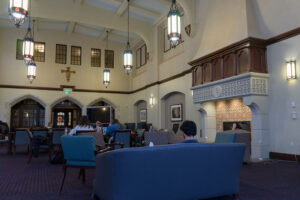
by Marla Gagne ’19
News Co-Editor
“The beauty and elegance of the building matches the beauty and elegance of what takes place inside of it,” said Providence College philosophy professor and former Development of Western Civilization (DWC) Program director, Dr. Vance G. Morgan. The “beauty and elegance” Morgan admiringly referenced was then the newest creation at PC, a hybrid of tradition, classical architecture, and the fast-paced technological world of the present. Today, we know it as the Ruane Center for the Humanities.
The Gothic style 63,000 square-foot building, most famous for its DWC lectures and seminars, was first constructed in 2012 after alumni Michael A. Ruane ’71 &’13 Hon. and his wife Elizabeth donated money for the new facility. The building would open only 18 months later, becoming home to the School of Arts & Sciences, the Humanities, the DWC program, the Liberal Arts Honors Program, and the English and history departments.
For PC students today, Ruane is one of many buildings visited in their daily schedules, a hotspot for coffee lovers, and a great spot for studying. However, only four years ago the current seniors were entering Ruane as the first students to use the facility. Gabby Shkreli ’17 remembers walking into the archway of Ruane and “being in awe of its castle-like beauty.”
“Being able to experience Civ in Ruane made class exciting and enjoyable, especially since we would be the first class to do so,” stated Shkreli.
Like many of the buildings and facilities that have been built on campus over the last few years, Ruane was the creation of generous alumni donations and constant construction.
Mr. Ruane graduated PC with an economics degree and became the founding owner, chair, and managing partner of Boston-based TA Realty, one of the nation’s top real estate investment advisory firms.
The “building for the ages” was not only funded by a PC alumni but also designed by one. Daniel S. Kantor ’92, principal and chief financial officer of S/L/A/M Collaborative, and Gerald J. Sullivan ’86, a principal in Sullivan Buckingham Architects, brought the $21 million project to life by the fall of September 2013.
PC then welcomed Yale University grad, Pulitzer Prize winner, and Presidential Medal of Freedom recipient David McCullough to dedicate the new building. Addressing an intimate crowd of 1,200 PC alumni, staff, and family during St. Dominic Weekend, McCullough was recorded in the Providence Journal saying, “I feel to the depths of my being that this emblematic new building is not only a step in the right direction for Providence College, but for our country. We need to be reminded about who we are and how we got to be who we are.”
McCullough would correctly predict how Ruane would become not only a center for the liberal arts, but a mediator between the past and present.
A Peek Inside: A New Era of Education
Ruane was designed in a Gothic style that features natural light and intricate masonry detailing, a tribute to Dominican tradition. Throughout its three levels, students are able to learn and study in new places for discussion.
Throughout the building, there are 181 rooms, including two lecture halls, two 50-60 seat classrooms, and numerous seminar spaces. All classrooms are equipped with up-to-date technology, including big screens and computers in lecture halls and flat screens and computers in seminar rooms.
During the groundbreaking of Ruane in 2012, Fr. Brian Shanley, O.P. ’80, said, “I am more excited about The Ruane Center for the Humanities than I have ever been about any new facility on this campus. Students learn differently now than they did 20 years ago…The Ruane Center will provide Providence College with state-of-the-art teaching and learning space that promotes dialogue between and among students and faculty while also encouraging greater student engagement in their scholarship and study.”
PC has continually pushed individual learning and open discussion, hoping for this idea to take shape in the new building and DWC program. Dr. Raymond Sickinger, professor and chairperson of the history department, agrees that Ruane has helped students taking DWC. “Ruane has enhanced the DWC experience. The large classrooms are not only better equipped for the best that technology can provide, they also provide a more flexible space to allow for some small group activities,” said Sickinger.
As a student, Shkreli felt the seminar rooms allowed her to be more involved in class and be part of the discussion, not just watch it. “Because I could see all of my classmates’s faces while discussion took place, Civ seminar felt much more personal and intimate. I loved that, when a teacher asked a question and someone answered, they were able to pose their answer to the whole class, rather than just back to the professor. In this way, Civ—and the professor—became much less intimidating and much more engaging.”
While Ruane is the center for learning, it also possesses unique features for students, faculty, and staff. Students can be found all night studying in the Great Room, the space notable for its cozy fireplace, Hogwarts-esque design, and go-to spot for intimate College functions. As midterms are in full swing, the Starbucks spot and connector between Ruane and the Phillips Memorial Library only seems to get busier.
The basement level is a “retreat space” that allows students, faculty, and staff to discuss and debate issues on the couches and six-person tables equipped with two computers, a printer, and a white board. When the weather is nice, students move their conversations outside to the first floor patio overlooking the pathway to Slavin. Students also collaborate in a special spot on the second floor, the watchtower classroom that gives students a 180-degree view of the campus and a chance to sit at the desk of former President Woodrow Wilson.
While the building is often noticed for its design, its style goes beyond just looking good.
Carly Martino ’19 believes PC focused on giving the building a classical look because Civ is all about revisiting the classics. The building makes Martino “feel like you can ‘transport’ into that time period.”
Shkreli, a marketing major with an English minor, has also enjoys the new Arthur F. and Patricia School of Business Studies. “Yet, whereas the business center, for me at least, symbolizes growth, innovation, and hope for the future, I think Ruane is so important and special because it serves as a reminder of our past, a representation of our roots as a people,” said Shkreli.
Almost four years ago, PC set out to create a new style space for collaborative and community learning with the newest resources while also maintaining its Dominican and Liberal Arts identity. And as the campus continues to expand and other colleges move away from the small liberal arts community, many faculty, staff, and students believe Ruane will keep the campus rooted to its core values.
Dr. Steven Lynch, English professor and director of the Liberal Arts Honors Program, said, “Many colleges and universities are shifting resources away from the humanities—and I think in the long run that will prove a mistake. Here at PC we are fighting an uphill battle because so many students want to major in something immediately marketable. But the Ruane Center will serve as a reminder every day for students and faculty that a seriously educated person must be grounded in the humanities.”
Friar Flashback: Sitting with Fr. Shanley
by The Cowl Editor on March 3, 2017
News
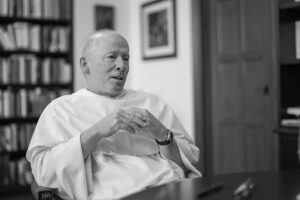
by Meaghan Dodson ’17
News Co-Editor
He has taken on nearly every role that Providence College has to offer: student and hall director, priest and professor, Board of Trustees member and, ultimately, president of the College.
He has been connected to PC for over 40 years and during this time he has seen it transform from a small Rhode Island college to the premier Catholic liberal arts institution it is today. In fact, he did not just witness this transformation, he helped facilitate it.
He is none other than Fr. Brian Shanley, O.P. ’80, who—as the College celebrates its 100th birthday—sat down with The Cowl to discuss ways in which he has seen PC grow over the past several decades.
Fr. Shanley first stepped onto campus in the fall of 1976. His father was a PC alumnus and Board of Trustees member, and his mother was a librarian at the Phillips Memorial Library. “Her faculty status meant I got free tuition,” he stated. “It didn’t make economic sense to go anywhere else.”
PC’s latest purchase was the Chapin property (the hospital complex that today forms lower campus), which had been acquired only a few years earlier. With dreams of law school in mind, Fr. Shanley thought he had no choice but to major in political science.
It was Fr. Coskren O.P., the assistant director of the Liberal Arts Honors Program at the time, who told him this was not the case. “Pursue what you love,” Fr. Coskren advised. And so Fr. Shanley became a history major, spending the next four years taking in all the College had to offer.
A member of the Liberal Arts Honors Program, Fr. Shanley attended his Development of Western Civilization classes in the basement of the former Stephen Hall, which is now the Feinstein building. The format of “Honors Civ” resembled the current DWC format, while the general DWC program—which was housed on the first floor of Aquinas Hall—consisted of five lecture-based classes per week.
His favorite class at PC? “Definitely Civ,” he revealed. And his favorite subject? “Thomas Aquinas. This is all him,” he stated, pointing to the better half of his office’s bookshelves.
His professors included the likes of Dr. Raymond Sickinger, current chairperson of the history department, and Dr. Richard Grace, professor emeritus of history and the College’s official historian. Fr. Shanley was very focused on his studies and thus PC’s future president was ironically fairly uninvolved on campus. “I was never a joiner,” he stated, revealing that intramural sports were the extent of his extracurricular activities.
And what was campus like at this time? Women had first been admitted to the College a few years prior to his attendence, by the time Fr. Shanley arrived in 1976, the co-ed life was “old news.”
“One of the biggest differences was that about half the College’s population was commuters,” he stated.
Fr. Shanley, however, was not among this number. He lived in Guzman Hall his freshman year and then moved to Raymond Hall (a male dorm at the time) for his sophomore year. Two or three Dominicans lived in each residence hall, and it was this close contact, Fr. Shanley revealed, that helped inspire him to become a priest.
Speaking of Ray, what was Fr. Shanley’s favorite meal when he was a student? The campus’ dining hall was “not memorable” at the time, he admitted. There was a single serving line down the middle of Ray, and there was one option per meal which was typically a meat, a potato, and a vegetable. Otherwise, students were stuck with PB&J. “Nowadays,” he stated, “Students do not know how good they have it. I still eat in Ray occasionally.”
Fr. Shanley studied abroad in Switzerland for his entire junior year and senior year he lived off campus on Veazie Street. “We called it ‘Sleazy Veazie,’” he joked.
Indeed, the majority of juniors and seniors lived off campus at the time. The apartment complex of DiTraglia, Mal Brown, and Cunningham Halls—which, for the first few years, were simply labeled A, B, and C—were not be built until the late ’80s.
After college, Fr. Shanley immediately began his journey to priesthood. “I graduated in May, and I arrived in Dover, Massachusetts [where the seminary was located] on August 7, 1980.”
Among his fellow novitiates were Fr. Mark Nowel, O.P., dean of undergraduate and graduate studies, and Fr. Iriarte Andújar, O.P., associate dean of admissions.
Fr. Nowel, Fr. Shanley revealed, arrived sporting a fake British accent, the result of recently acquiring his Ph.D. in England.
Fr. Shanley was ordained a priest in 1987 and in 1988 he returned to PC as a philosophy professor and hall director. He served as hall director for Stephen Hall which, at the time, housed all of the College’s male scholarship athletes. “It was two of the most interesting years of my life,” he laughs.
In 1991 he left to pursue a Ph.D., one of the five degrees he holds, and then from 1994 to 2005 he taught philosophy at the Catholic University of America. He was still connected to the College, however, as he had been a member of the Board of Trustees since 1998.
In 2004, Fr. Philip A. Smith, O.P., announced his intent to retire as PC’s president, and Fr. Shanley was encouraged to throw his name to the mix. “I didn’t think I was going to get the job,” he revealed.
But he did get it, and he has been the president of the College ever since. The first student he interacted with after his appointment, he stated, was none other than The Cowl’s News Editor at the time. Fr. Shanley has had a long history with The Cowl as his father served as co-editor from 1948-1949.
Upon assuming the presidency in 2005, Fr. Shanley recalls that among the campus’ newest buildings were St. Dominic Chapel and the Smith Center for the Arts. The “don’t step on the chapel circle” superstition, he argued, is nothing more than a myth. “The stone has only been there since 2001!”
The first structure built under Fr. Shanley’s supervision was the Concannon Fitness Center. Prior to that, the “gym” was in the basement of Alumni Hall where the current ROTC office is situated.
Indeed, Fr, Shanley revealed that the collective Slavin Center/Alumni Hall complex was much smaller when he was a student. Peterson Center was not built until the early ’80s, and Slavin Center was initially conceived to be a large, five-story building before the College ran out of money. This is why the stairs behind the “Fishbowl,” for example, are so steep; the space was designed to be an elevator shaft.
Since 2005, Fr. Shanley has worked to promote the academic and physical transformation of the campus. The DWC program underwent major construction in 2012 while, in terms of physical layout, the Ruane Center for the Humanities, Schneider Arena, Chapey Field at Anderson Stadium, and, most recently, the Arthur F. and Patricia Ryan Center for Business Studies became the most recent additions to campus.
As PC enters its centennial year, Fr. Shanley looks both back into the past and forward towards the future. “I walk past all these pictures [in Harkins Hall] every day; I look at the history of the College on a daily basis,” he stated. “I think about where we were when we started, and as I look at what campus is now, I think about how everything has changed but also how nothing has changed. From an academic and physical point of view, the founders [of the College] would be amazed at where we are now. But the mission of educating in the Dominican Catholic tradition has remained the same. We have never changed our core values; we have stayed true to the vision that Bishop Harkins and the founding Dominicans had 100 years ago.”
Friar Flashback: Very Superstitious…
by The Cowl Editor on February 17, 2017
News
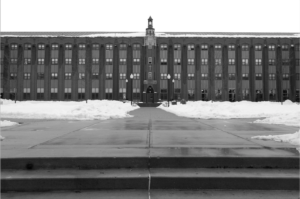
by Marla Gagne ’18
News Co-Editor
Cursed Circle:
One day Wanda Ingram ’75, senior associate dean of undergraduate studies and freshman class dean, was beginning her first year at Providence College, the newly co-ed school. As she walked with fellow classmates into Raymond Dining Hall, she noticed the people around her quickly moving to avoid something on the floor. What was going on with the sporadic movements that left people jumping away from her? Nothing too crazy—just a little superstition.
Ingram soon found out that the weird behavior she was witnessing was simply to avoid a circle in Ray with the school insignia. Rumor had it that one step on the seal would bring bad luck. Ingram laughs as she thinks back to the superstition, something she personally never believed in, while Dr. Raymond Sickinger ’71, history department chairperson and professor, recalls always avoiding the circle like most students at the time.
Fast forward to 2017, and the circle has moved but the superstition is the same. Most students on campus agree that everyone must avoid walking on the plain grey circle in front of St. Dominic’s Chapel or face the consequences.
Alexandra Jones ’17, who firmly believes in avoiding the circle, first heard about the curse on a school tour. Her guide said, “If students step in the circle, they won’t graduate. If parents [step in], they won’t get good financial aid.”
And, while there may be some who doubt the power of the circle, Joe Flynn ’15 ’17G said his sister, who didn’t hold the same belief, stepped on the circle during a tour and never got into PC.
The origins of the superstition remain unknown, but Jones thinks it might be like people spinning on circles before boarding a plane. If there is a “circle somewhere, you have to do something [even though] it doesn’t make sense,” said Jones.
Some are avid believers in the circle’s powers, others just see the circle as concrete.
But whether it is a seal in Ray or a circle near the chapel, most students might agree with Michael Scott from The Office who says, “I’m not superstitious, but I am a little stitious.”
Scream Like You Mean It:
It was the best of times, it was the worst times: It was Civ. Since its formation in 1971, Development of Western Civilization (DWC) has been a unique part of PC’s liberal arts education. Students study thousands of years of history across multiple disciplines, learning about the cultures that shaped the Western World.
DWC is also notoriously difficult. The essays are complex, the seminars are long, and the homework is never ending. In celebration of finally conquering long nights of studying and hard work, students gather the night before their final DWC exam and scream out two years of feelings.
Flynn said DWC Scream is simply freshmen getting excited because it is their first one, sophomores feeling glad to be done with DWC, juniors usually not being interested, and seniors going crazy—“it’s the thing before graduation and commencement.”
Dr. Sickinger can recall Civ Scream being an event when he returned to PC as a professor in 1974. Ever since then, students have continually gathered to celebrate surviving DWC and having a night of fun.
Every Civ Scream is different and, after a seemingly long period of silence and waiting, crazy events take place. Students in just the past five years have seen everything from burning couches and fireworks to students streaking across campus. Mascot costumes and horse masks always make an appearance and sometimes students go for a swim in mini pools and slip ‘n slides.
Recent PC classes have failed to have this classic DWC experience. Security has heightened over the past few years to control any crowds and prevent property damage. Although he knows it can get out of hand some years, Flynn says he is glad to have experienced Civ Scream during his time at PC. “It’s a fun tradition,” he said, “And a cathartic release.”
Honorable Mentions:
To cover all superstitions and traditions over 100 years would be impossible, but here are some that have survived the test of time:
Rumor has it that Doore Hall, along with other lower campus buildings that used to be part of a medical institution, is haunted by the ghosts of patients.You have never really lived at PC if you have not hungout at the Quad, sled down Guzman Hill, or taken a picture with the country’s creepiest mascot: Friar Dom.
And while most students are glad to wear jeans and T-shirts to class, students before 1971 used to follow a dress code of a sports coat and tie. Freshmen were also forced to wear small hats with their class year on them, allowing seniors to identify and order them around.
As PC flies into the future and looks forward to another 100 years of success, it brings the traditions, for better or worse, with it.
Friar Flashback: Looking Back With Alumni
by The Cowl Editor on February 10, 2017
News
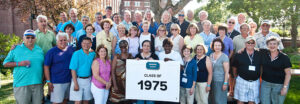
By Marla Gagne
News Co-Editor
Throughout the years, thousands of alumni have graduated from Providence College and witnessed the campus transform. Some of those alumni dedicated to education and the mission of PC have returned to campus to continue to guide new generations of students. As PC charges into a new era, here are some of the voices from its past.
In 1971, Providence College was a different campus. Every student was male, mass was held at Guzman Chapel, about 75 percent of students commuted, and the notorious Development of Western Civilization program was just being created.
“It was a schizophrenic class,” says Dr. Raymond Sickinger ’71, chairperson and professor of the history department. As he looks back on his time at PC, he recalls that it was a great time of change, both on campus and across the country.
Dr. Sickinger grew up locally and attended La Salle Academy with now Rhode Island Senator, Jack Reed. The dream of going to college was not always financially possible, but became a reality after he graduated as valedictorian, securing a full ride to PC.
The early 1970s was the “era of the coffeehouses.” Dr. Sickinger played coffeehouses in Rhode Island and New York and was even roped in by Fr. Paul Philibert, O.P. ’58, to play guitar during mass. Dr. Sickinger said it was a “subtle way that kept me close to the Catholic Church,” carrying on the Dominican tradition of really looking out for the individual student. Dr. Sickinger also recalls sitting on the steps of Aquinas Hall as the whole school was shut down to allow students to protest the Vietnam War.
He would later return to PC after graduating from the University of Notre Dame. Upon his return, he saw a co-ed campus and DWC coming to life, a program he had input in as a student.
Looking back, Dr. Sickinger confidently believes that if “[PC] had not gone co-ed, it probably wouldn’t exist today.” This “right decision at the right time” allowed women to bring a new perspective to each class, especially as historians began to recognize women’s influence in history.
As for DWC, he believes DWC has “made [him] a better teacher and historian.” Civ has allowed students and professors to see the overlap of different disciplines, focusing not just on history but literature, philosophy, and theology as well. Students also begin to understand the strengths and weaknesses of the Western culture. Only by “understanding our own culture” can students “understand other cultures.”
Dr. Sickinger continues to watch the school transform and notes how alumni are “absolutely floored” when they return. He believes the College will continue to move in the right direction as long as they “don’t lose the liberal arts foundation” that has allowed PC to be a unique and thriving college
Before Wanda Ingram, senior associate dean of undergraduate studies and freshman class dean, came to PC, it was still all men and majority white. A self-labeled military brat, Ingram was located at a Newport base and looking at local colleges like Worchester and Brown University. But after some persuasion from a PC alum and high school guidance counselor, she attended PC.
Ingram recalls often standing out wherever she went, being part of the first class of women and a woman of color. She recalls in that first year “there was no mixing of genders at all.” Female students were located in Aquinas, also the home to DWC, and any males, including fathers, could not move past the lobby.
Racism was something that Ingram faced at the time and often just “dealt with it.” With only about 12 women of color on campus, she was constantly being watched. She recalls experiences where some students, professors, and Friars would tell her she did not belong here and assumed was on scholarship.
A great source of her support and close relationship came from fellow students of color and older African American men, her so-called “older brothers.” They formed a tight community and would have each others’ backs through the ups and downs of school.
Looking at PC today, Ingram sees the beautiful transformation of the campus and the continued success of students and alumni. In reaction to recent protests on campus and across the country, Ingram says she is “so sad to be seeing the same things all over again,” but she has great hope that everyone will continue to do the work that needs to be done with time and patience.
For Dr. John Breen ’81, the chairperson and professor of the chemistry department, coming to PC was not something that happened by chance—it was in the family. His father, John J. Breen ’47, taught in the business department for 46 years. With free tuition, Dr. Breen took advantage of the great deal and attended PC as a commuter student.
Dr. Breen found a home with the PC Men’s Track and Cross-Country Team, finding them to be his main social circle on campus. He also experienced DWC in its original form when it was five days a week for 50 minutes and four semesters with seminars thrown in throughout the semester.
Dr. Breen recalls, “It was hard to get an A, but with a reasonable effort B and B+ grades were achievable.” He kindly remembers two of his favorite professors, Professor Delesanta and Professor Grace, but also the tough freshman exams. Over 200 students were in Harkin’s auditorium where they faced a 23 page narrative with 164 fill in the blanks. People just started to give up and leave after three hours. But he believes “Civ has come a long way from that and is now a course where connections between ideas, literaryworks, and historical events are made and students are asked to write and re-write papers demonstrating that they recognize the importance of these connections.”
After working in Indiana for 10 years, Dr. Breen’s wife was tired of living out west and wanted to move back to New England. After some job searching, he discovered PC had a spot for a chemist open. “I can say I am very happy we made the move and I have never looked back.”
Every new academic year, Dr. Breen is excited to be back at PC to see a new class of students. “I like the ‘spring like’ feel I get every fall when the campus comes alive again with students and the new freshman class arrives.” He also is excited to continue to “learn new things about chemistry, matter, etc. and I get to do that as I continually change my upper level courses.”
As Dr. Breen thinks back on his own experience and PC today, he wants the College to be a “safe and supportive environment” and a place that everyone can “look fondly back on their time at PC as being central to their growth into adulthood. “
Friar Flashback: War Memorial Grotto
by The Cowl Editor on February 3, 2017
News
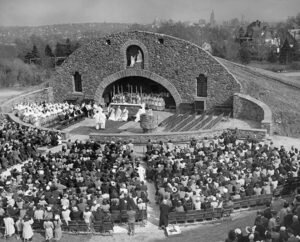
By Marla Gagne
News Co-Editor
In 1948, Fr. Charles H. McKenna, O.P., a local Rhode Islander and Providence College alumnus, set out to build a memorial that would not only honor the dead, but also be a place of peace and comfort for the living— and he did just that.
St. Dominic Chapel is an integral part of daily life for PC students; where they can go to mass, meet with Friars, and hang out with students. But before the Chapel existed, the center of student life and religion was the grotto.
Adjacent to the chapel is a piece of the current War Memorial Grotto, originally created in 1948 to honor the fallen Providence College men during World War II. Three thousand, three hundred men, both alumni and current students, enlisted in the armed forces between 1941-1945; 69 of those men never returned home.
Fr. McKenna, a PC alumus and Dominican from Pawtucket, decided that these men should never be forgotten. Serving as the chaplain of the student body in 1938, he headed a campaign to build the grotto.
According to the Phillips Memorial Library records, McKenna championed a vision that “encompassed the idea that this would be not just a memorial, but also a place where future generations of PC students could find a place of quiet refuge from their hectic daily lives.” Still the center of daily life at PC, McKenna’s dream holds true 79 years later.
From its inception, the memorial has been a community effort. PC families, alumni, students, and fellow Rhode Islanders fundraised the majority of the money to build the memorial. One of the biggest fundraising events was a Penny Sale at the Rhode Island Atrium. The 1949 event drew in over 15,000 people, a record crowd, and was a great success, raising $41,000.
On-campus clubs also donated money from festivals and on-campus events. Students even took the lead when it came to the actual building of the memorial, often volunteering their time to help with construction. The students’ help and donated materials from the community greatly brought down construction costs.
On a windy day in May, less than a year after construction started, religious and government figures joined the ranks of 10,000 people to see the dedication. The College’s President, Father Robert J. Slavin, O.P., presided over the ceremony, while Father Harold C. Boyd, O.P., gave the homily.
His sermon focused on “The parallel of the martyrdom of motherhood of the heroes who gave their life for the preservation of freedom and the ideas of Christianity and the significance of the sublime example of the Mother of Christ.”
The memorial adorned two Italian carved Carrara marble statues at the center, showcasing St. Dominic receiving the rosary from Mary. There was a custom Wurlitzer organ, bronze altar appointments, and black granite Honor Roll panels that hung on both sides of the altar and read the names of the fallen students.
While the grotto would continue to serve as a somber reminder of the young lost, it also brought new life to the College. Students sunbathed on what was known as the “Beach Grotto,” played baseball or frisbee, or just brought blankets to hang out.
Old photos show crowds of students showing up in their bathing suits to enjoy good weather, live music, and parties.
The spot also held Sunday mass and evening mass, Diocesan Retreats, parents’ night, and the graduating class’ baccalaureate mass, among other services.
By the 1980s, the use of the grotto began to show. The campus saw the memorial’s “slow deterioration,” while also facing the problem that the “campus chapel facilities were clearly inadequate to meet the spiritual needs of a growing student body.”
The Ad Hoc Committee for the War Memorial Grotto under the College’s president Fr. John F. Cunningham, O.P., decided to keep “the key components of the Grotto while constructing a new campus chapel.”
The 117 foot chapel was inspired by Byzantine and Italian structures and can hold 600 people.
Many structures were made in Italy, 45 stained glassed windows adorned the walls, and the relics of saints, such as St. Catherine of Siena, St. Thomas Aquinas, St. Dominic, St. Agnes, and Blessed Melchior are entombed in the chapel’s altar.
By 2001, the chapel and new memorial were completed. Adjacent to the chapel lies the new memorial, one third of the original size, and still possesses the same stonework, statuary, and memorial plaques.
The grotto, although not the massive structure it once was, still continues to hold the memory of fallen students and is an everyday part of current PC life.
By 2001, the chapel and new memorial were completed. Adjacent to the chapel lies the new memorial, one third of the original size, and still possesses the same stonework, statuary, and memorial plaques.
The grotto, although not the massive structure it once was, continues to hold the memory of fallen students and be an everyday part of current PC life.
Friar Flashback: The COWL
by The Cowl Editor on January 27, 2017
News
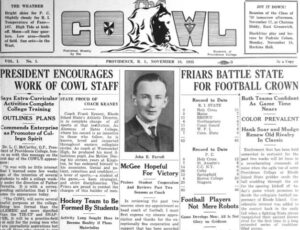
by Gabriella Pisano ’18
News Staff
While the Internet may be a source of news for many, newspapers continue to be one of the more reputable places to find factual news about events. Many different newspapers exist, providing a wealth of different information. The Cowl is Providence College’s very own newspaper.
With its first publication in November 1935, the newspaper has been publishing ever since. Since the first issue of The Cowl, the fact that it is student-run has been emphasized, with each issue stating on the front page “Providence College’s Student-Run Newspaper since 1935.”
As a student-run newspaper, the entire process of writing and assembling the newspaper is up to students. Students choose the topics of articles, discuss subjects, review and edit other student’s materials, design the layouts, produce and distribute the newspapers, as well as solicit advertisers.
In the early years of The Cowl, publications varied in length, but were typically only a few pages long and were published sporadically throughout the years. Now, weekly publications of The Cowl are significantly larger.
Like other newspapers, The Cowl covers a range of topics split into different sections. The main sections that have existed for quite some time include News and Sports. Other sections, such as Arts & Entertainment and Opinion, have existed under other names throughout the publications. Another section in The Cowl is Portfolio. This section is more recent than others. Portfolio includes creative writing pieces as opposed to the other sections that are more news oriented.
Discussing her observations on the changes within The Cowl, last year’s Editor-in-Chief, Kathleen McGinty ’16, stated, “Over time, sections have evolved. Just during my four years on The Cowl, I remember our Commentary section changed to Opinion, and we voted to disband the World News section.”
With many students writing for each section, there are also student copy editors. Each article published in The Cowl goes through three rounds of review by the copy editors. The Editor and Associate Editor in Chief have the final say over what gets published.
Though The Cowl does have an administrative advisor, Richard Kless ’74, students are very much in charge of the newspaper. Explaining his role as advisor, Kless states, “My role is primarily one of guidance, resource, historical reference, but never a controller.”
While there tends to be confusion surrounding the true role of an advisor to a student-run newspaper,
Kless clears this up, stating, “Contrary to popular opinion, an advisor’s role is not to control what the students want to say but to help guide them to express it in such a way that the newspaper serves and informs the PC community.”
The Cowl publishes weekly on Thursdays, and is available around campus. With the emergence of the Internet and improvements in technology, an online publication is also available on thecowl.com.
Kless stated, “Since the explosion of technology it has been suggested from time to time that The Cowl stop being a hard copy paper and go strictly online.”
“Institutions of Higher Learning that have done so often regret it later as it reduces a student ‘paper’ to a few bloggers,” he continued. “It eliminates the opportunities for students to interact face to face with one another. It reduces a club/organization to a handful by ceasing the need for editorial meetings, copy editor reviews of peers’ work, layout opportunities for skills to develop in producing the hard copy, etc.”
Though being available in online form is beneficial, the production of the student-run paper provides students both participating in the production, and those consuming, with skills that will benefit them in the future.
Katherine Puzycki ’17, the current editor-in-chief of The Cowl, stated, “One of the best parts of being the Editor-in-chief of The Cowl is getting to hold a physical copy of the paper in your hands after it’s been printed. To see everyone’s work come to life like that is rewarding in a way that makes me proud to be part of such a great publication and to work with such a talented staff. We pour countless hours each week into making The Cowl a tangible product that the College will always have—it speaks not only to the legacy of our school, but the legacy of each person that has been a part of our paper.”
